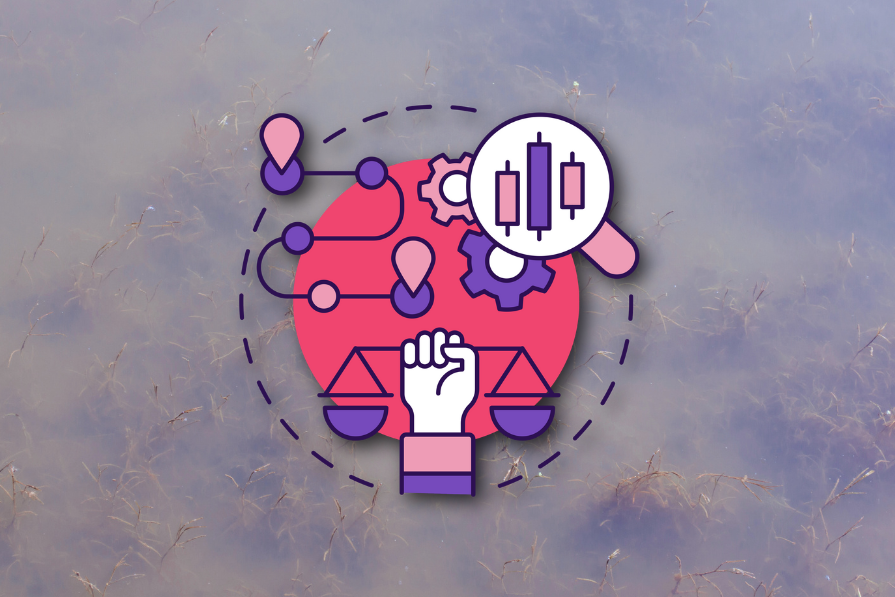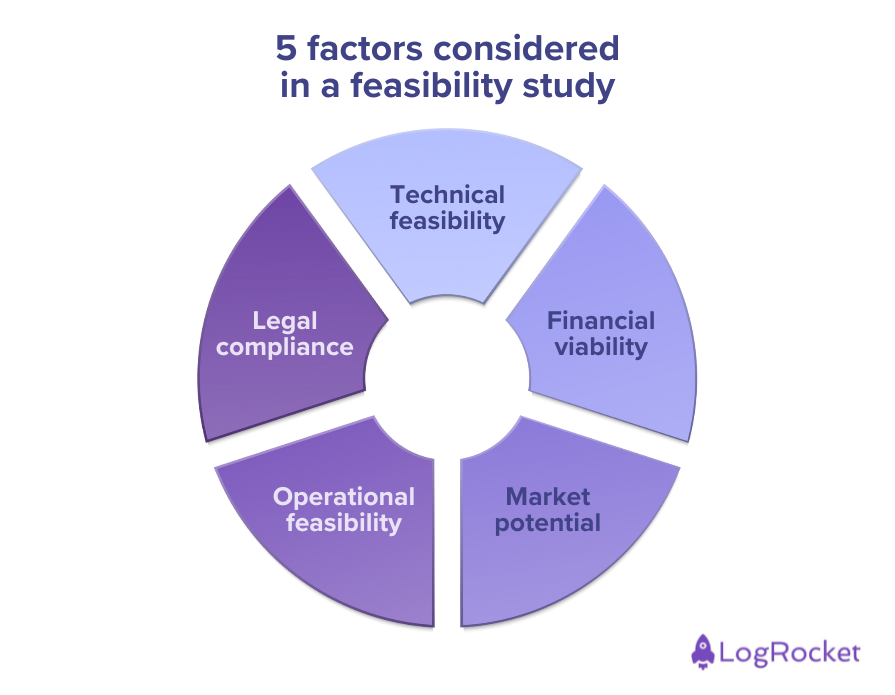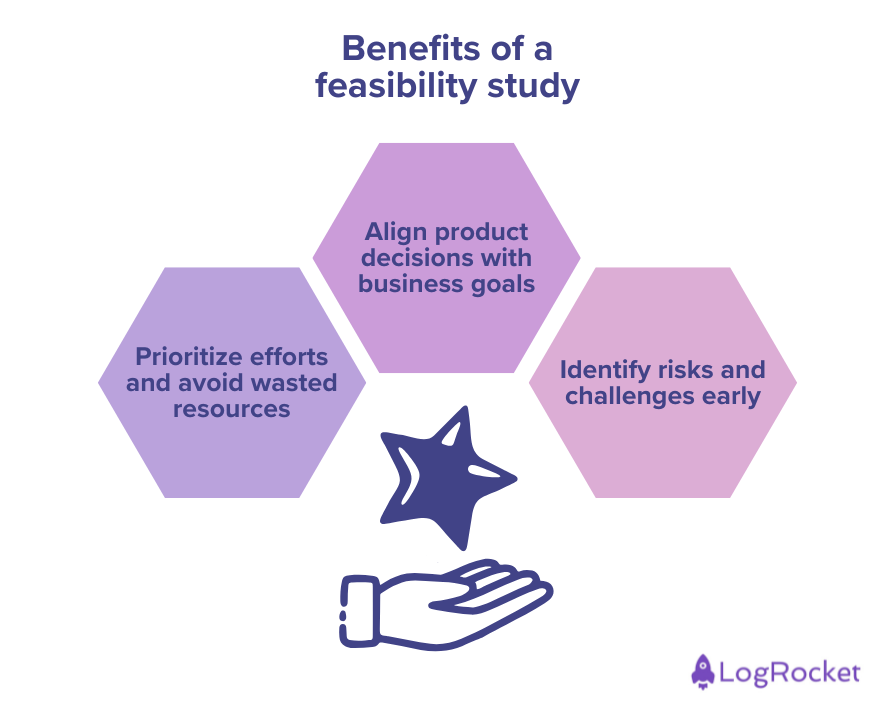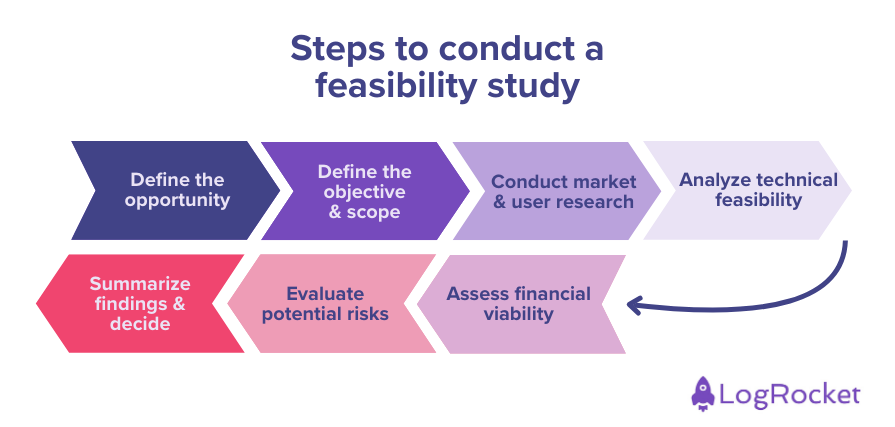A feasibility study helps you figure out if a project is worth the investment — financially, technically, and operationally. Whether you’re exploring a new product launch or expanding into a new market, this study looks at things like market fit, costs, and potential risks. It’s essential for making smart, data-backed decisions and reducing the chances of a project failing.

In this article, we’ll break down what a feasibility study is, how to conduct a feasibility study, and share examples of feasibility studies.
Plus, you can grab a customizable feasibility study template to start your own evaluation.
Editor’s note: This article was last updated on 2nd April 2025, to expand coverage to broader feasibility study frameworks (business, technical, financial, regulatory, etc.). Additionally, People Also Ask (PAA) questions were addressed. The previous update by Kayode Adeniyi on 7 January 2025 added more comprehensive, practical guidance regarding how to conduct a feasibility study template. The updated, customizable feasibility study template can be downloaded here.
A feasibility study, also known as a feasibility assessment or feasibility analysis, is a systematic evaluation of a proposed business initiative, project, or product to determine its viability. It helps organizations assess whether an idea is practical, profitable, and achievable before committing significant time, capital, and resources.
Feasibility studies are commonly conducted before launching new businesses, expanding operations, investing in infrastructure, or developing new products and services. They help stakeholders make informed decisions by identifying risks, estimating costs, analyzing market potential, and ensuring regulatory compliance.
A feasibility assessment typically considers five core factors — technical feasibility, economic feasibility, scheduling feasibility, operational feasibility, and legal feasibility:

You might conduct separate feasibility studies for each of these areas or integrate them into a single comprehensive assessment. Based on the findings, your team can decide whether to proceed with the opportunity, adjust its scope, or pursue an alternative solution.
Let’s get into these factors in more detail.
Technical feasibility examines whether the necessary technology, tools, and expertise are available to develop and implement the project. It identifies potential technical barriers and evaluates whether the organization has the capability to implement the project.
Example — A software company exploring an AI-powered customer support chatbot would assess the need for machine learning expertise, compatibility with existing systems, and data security requirements. A potential challenge might include integrating the chatbot seamlessly with the company’s CRM platform while ensuring compliance with GDPR.
Key considerations:
Economic feasibility determines whether the project is financially viable by analyzing costs, revenue potential, ROI, and overall financial risks. This factor is crucial for businesses evaluating the profitability and sustainability of a venture.
Example — An ecommerce platform considering a drone delivery service must calculate upfront costs (drones, training, infrastructure), ongoing operational costs, and projected revenue from faster delivery times that might attract premium-paying customers.
Key considerations:
Legal feasibility ensures that the business initiative complies with laws, regulations, and industry standards. This step identifies potential legal hurdles and liabilities that could affect implementation.
Example — A food delivery service planning international expansion must navigate labor laws, food safety standards, and cross-border tax regulations. Legal counsel may be required to handle compliance in multiple jurisdictions.
Key considerations:
Operational feasibility assesses whether the organization has the internal resources, workforce, and infrastructure to support the initiative effectively. It examines day-to-day operational challenges and the ability to scale the project.
Example — A retail chain expanding into same-day delivery must evaluate warehouse management, route optimization software, and staffing levels to ensure smooth operations.
Key considerations:
Scheduling feasibility evaluates whether the project can be completed within a reasonable timeframe, considering potential risks, dependencies, and constraints. Delays can significantly impact costs and market competitiveness.
Example — A manufacturing company developing a new product line must assess production timelines, material sourcing challenges, and regulatory approval wait times.
Key considerations:
Imagine a B2B SaaS company considering the development of an AI-powered analytics dashboard to help enterprise customers optimize supply chain efficiency. The product team conducts a feasibility study, leading to the following insights:
The study concluded that the initiative was feasible, leading to a beta launch with early adopters. Within six months, customer retention increased, and enterprise clients reported a 15% improvement in supply chain efficiency, validating the product’s value proposition.
| FEASIBILITY TYPE | FOCUS AREA | EXAMPLE CONSIDERATIONS FOR PMs |
| Technical feasibility | Technology, infrastructure, and expertise | Can the development team build this feature with the current tech stack? Are there scalability concerns? |
| Economic feasibility | Financial viability, cost-benefit analysis | Does the expected revenue justify the development and maintenance costs? What is the projected ROI? |
| Legal feasibility | Regulatory compliance and legal risks | Does the product comply with data privacy laws (e.g., GDPR, CCPA)? Are there licensing or patent issues? |
| Operational feasibility | Internal capability, workforce, and scalability | Does the company have the necessary engineering and design resources? Can customer support handle the new feature? |
| Scheduling feasibility | Timeline, risk management, and delays | Can this feature launch within the planned roadmap? What risks might cause delays (e.g., dependencies on external APIs)? |
Here’s why conducting a feasibility study is essential and how it benefits businesses:

Investing time, money, and effort into a project that ultimately fails can be costly, both financially and reputationally. Feasibility studies help teams assess viability early, ensuring resources are allocated to initiatives with a higher likelihood of success.
Imagine, for example, a retail chain considering opening a flagship store in a new city. A feasibility study might reveal that the target market lacks sufficient purchasing power or that existing competitors dominate the area, making the venture unlikely to succeed. With this insight, the company can redirect resources to a more promising location or strategy.
Consider a different scenario where a SaaS startup is planning to expand internationally. Conducting a feasibility study highlights data privacy regulations like GDPR in Europe and reveals a lack of language support for non-English-speaking markets. The team uses this insight to prioritize localization efforts and regulatory compliance before launching.
Key benefits:
Feasibility studies ensure that projects align with an organization’s strategic objectives, core values, and long-term vision. Systematically evaluating the project’s scope and potential allows teams to avoid initiatives that deviate from business priorities. Demonstrating how a product opportunity supports larger company goals can also help secure stakeholder buy-in.
Let’s say that a technology company specializing in enterprise software is considering developing a consumer-facing app. A feasibility study could show that such a pivot requires significant investment in unfamiliar markets, misaligning with the company’s B2B expertise and long-term growth strategy. Instead, the company may choose to double down on its enterprise focus.
Another example could be an ecommerce platform considering adding augmented reality (AR) features to enhance the shopping experience. A feasibility study uncovers the technical complexity of integrating AR tools with the existing platform, as well as a significant upfront cost. However, it also identifies a high ROI potential in product categories like furniture and fashion. This targeted insight helps the business secure stakeholder buy-in.
Key benefits:
Every project carries risks, but identifying and mitigating them early can save time, money, and reputational damage. Feasibility studies analyze potential hurdles, technical, financial, operational, or market-related, before they become costly issues.
For example, a startup exploring a subscription-based meal delivery service might use a feasibility study to uncover:
Identifying these risks early allows the team to adjust their strategy accordingly, focusing on urban areas or introducing a tiered pricing model.
Similarly, a hospital exploring telemedicine services could use a feasibility study to evaluate the technical infrastructure required, patient adoption rates, and the cost of compliance with HIPAA regulations. The study’s findings help them implement a pilot program for high-demand specialties, maximizing impact with minimal risk.
Key benefits:
The activities involved in conducting a feasibility study differ from one organization to another. Also, the threshold, expectations, and deliverables change from role to role. However, a general set of guidelines can help you get started, as can this sample template that you can customize to your needs.
Here are some basic steps to conduct and report a feasibility study for major product opportunities or features:

Defining the opportunity is critical to a successful feasibility study. Use data to substantiate the problem and its impact, ensuring relevance and clarity:
Data-driven insights ensure a solid foundation for the feasibility analysis.
Defining the objective and scope ensures alignment with organizational strategy and sets clear boundaries for the project:
Clarity in these areas ensures focused execution and measurable success.
Market and user research are critical for understanding your target audience, identifying opportunities, and validating the need for your project. This step combines qualitative and quantitative methods to gather actionable insights and ensure the project aligns with market demands.
Some helpful research methods include:
Meanwhile, these steps will guide you through conducting market analysis:
Analyzing technical feasibility ensures that your project can be successfully built and implemented with the resources, tools, and expertise you have. This step works best when you collaborate closely with your technical team to uncover challenges, allocate resources effectively, and plan for smooth execution:
By collaborating with your technical team and planning resources thoughtfully, you’ll be prepared to tackle challenges and deliver a project that’s both feasible and effective.
Evaluating financial viability ensures your project is not only feasible but also financially worthwhile. This involves analyzing costs, projecting revenue, and calculating return on investment (ROI) to provide a clear picture of the project’s financial outlook.
Start by identifying all costs associated with the project:
Let’s see how this could look using an example of a fitness app launching a premium feature:
This would bring the product’s total Year One costs to $200,000.
Next, estimate revenue based on pricing strategy and expected user adoption:
Continuing the fitness app example, let’s say that the premium feature will launch with a $20/month subscription and targets 5,000 users in its first year. The potential revenue would then be calculated like so: $20 x 5,000 users x 12 months = $1.2M.
Finally, calculate the ROI to demonstrate profitability:
This means the project generates five times the initial investment within its first year.
By presenting a clear financial breakdown, costs, revenue, and ROI, you provide stakeholders with a data-driven view of the project’s financial potential, helping them make confident decisions about moving forward.
Evaluating potential risks ensures your project is prepared to tackle challenges before they arise. Addressing risks across four key areas — technical, market, operational, and regulatory — can help you avoid costly setbacks and ensure a smoother implementation.
Proactively identifying and addressing risks in these areas equips you to create a clear, detailed, thorough plan that minimizes disruptions and sets your project up for success.
Effectively preparing and presenting the feasibility study report is critical to ensuring stakeholders understand your analysis and can confidently make an informed decision. Let’s break down how to approach this, starting with how to prepare the feasibility study report before looking at how to present that report.
Following these steps will result in a structured, visually engaging report that you can deliver and present confidently. By doing so, you ensure stakeholders have the clarity and insights needed to make the best decision for your project.
The ultimate challenge that faces most product managers when conducting a feasibility study is managing stakeholders.
Stakeholders, driven by their own perspectives and responsibilities, might raise concerns about the viability of your proposed product or feature, potentially even deeming it a misuse of valuable resources. They may even try to provide input on prioritizing your backlog, which, while well-intentioned, can be frustrating or create additional complexities for you.
Here are some tips to help you deal with even the most difficult stakeholder management challenges during a feasibility study:
Evaluation.
A feasibility study is a critical tool to use right after you identify a significant opportunity. It helps you evaluate the potential success of the opportunity, analyze and identify potential challenges, gaps, and risks in the opportunity, and provides a data-driven approach to market insights to make an informed decision.
If you’re dealing with challenging stakeholders, remember the importance of data-driven decisions, maintaining transparency, and leveraging the expertise of your team.
Using a feasibility study, product teams can determine whether a product idea is profitable, viable, feasible, and ultimately worth investing resources into. It’s a crucial step in the product development process, and when considering investments in significant initiatives such as launching a completely new product or vertical.
For a more detailed approach and ready-to-use resources, consider using the feasibility study template provided in this post. You can take a deeper dive into this template in our post that walks through why, when, and how to use it, along with tips for customizing the template to your needs.

LogRocket identifies friction points in the user experience so you can make informed decisions about product and design changes that must happen to hit your goals.
With LogRocket, you can understand the scope of the issues affecting your product and prioritize the changes that need to be made. LogRocket simplifies workflows by allowing Engineering, Product, UX, and Design teams to work from the same data as you, eliminating any confusion about what needs to be done.
Get your teams on the same page — try LogRocket today.

A practical five minute revenue estimation method to help product managers compare ideas, drop low impact features, and prioritize smarter.

A practical guide for PMs who want to stop being bottlenecks, delegate smarter, and lead teams effectively with a clear ownership framework.

Stop letting unreliable data block features. Treat data as inventory to track quality, ownership, and ship with confidence.

Learn why slide decks slow teams down and explore better tools like whiteboards, PRDs, and prototypes to improve collaboration and alignment.
20 Replies to "How to conduct a feasibility study: Step-by-step guide with examples"
I’m truly impressed by the depth of insight in your technical research! Your ability to unravel complex concepts and present them clearly is admirable. It’s evident that you have a profound understanding of the subject. Keep up the excellent work—your contributions are invaluable!
This is a well-structured guide to conducting feasibility studies. The step-by-step approach and real-world examples make it easy to understand and apply. A valuable resource for product managers!
This is a really helpful guide! I always wondered what went into a feasibility study. The examples are super clear and make it easy to understand the different factors involved. Definitely saving this for future projects!
This is a really helpful guide! I’m planning a new business and the examples are super useful to understand the different factors. Gonna download that template for sure!
This guide is super helpful! I’ve been so lost on how to start a feasibility study, and now I feel like I’ve got a solid roadmap. Thanks for breaking it down in such a simple way!
The phased approach to feasibility studies (technical → operational → economic) is spot-on. Most teams underestimate operational risks—like your example of legacy system integration blocking 42% of SaaS deployments. Adding a ‘legal feasibility’ checkpoint (GDPR/data sovereignty) would strengthen the framework, especially for global products.
This is a really insightful article about the importance of a feasibility study. It highlights the need to carefully consider all the angles before diving into a new project, which makes total sense. It’s almost like doing a little bit of research before you get too deep into something new you find online, gotta know what you’re getting into, right?
very good
A feasibility study sounds like a smart way to avoid epic project fails – something my last DIY attempt could have used! This breakdown is so clear, it makes me wonder if some of these “smart, data-backed decisions” are secretly being advised by a super-clever AI.
This article provides a clear and concise guide to conducting feasibility studies, making it a valuable resource for product managers and entrepreneurs. The real-world examples and template are particularly helpful.
Not bad
Great article! Feasibility studies can be pretty intense.
This is a great guide on feasibility studies! The examples are super helpful for understanding the concepts—especially the breakdown of economic feasibility with the drone delivery service. It really clarifies what to consider before starting a new project. Thanks for sharing this practical advice!
This sounds incredibly useful! A feasibility study is definitely crucial for any big decision, and I appreciate that this article not only breaks down the “what and how” but also offers a customizable template. Knowing it was just updated for broader frameworks makes it even more valuable.
This article looks incredibly useful! I really like the focus on checking project viability *before* investing time and money. A step-by-step guide, real-world examples, and a ready-to-use template are exactly what I need. This sounds like a great resource for avoiding costly mistakes!
This is a really helpful step-by-step guide! I’ve always been a bit confused about feasibility studies, but this breaks it down nicely. The examples are super useful too. Definitely saving this for later!
I’m planning a new project, and this breaks down the feasibility study process in a way that’s super easy to understand.
Great guide, I liked the clear step-by-step breakdown and the real-world examples that made each stage easy to picture. The ready-to-use template is especially valuable for getting started quickly and checking project viability before spending time or money.
Great guide on how to conduct a feasibility study. I liked the clear step-by-step approach and the real-world examples—they made the ideas easy to understand. The ready-to-use template is super helpful for getting started quickly.
Great guide — the step-by-step breakdown of feasibility study steps made the process feel manageable, and the real-world examples helped me see practical outcomes. I also appreciate the ready-to-use template; it would save time when checking a project’s viability before investing resources.